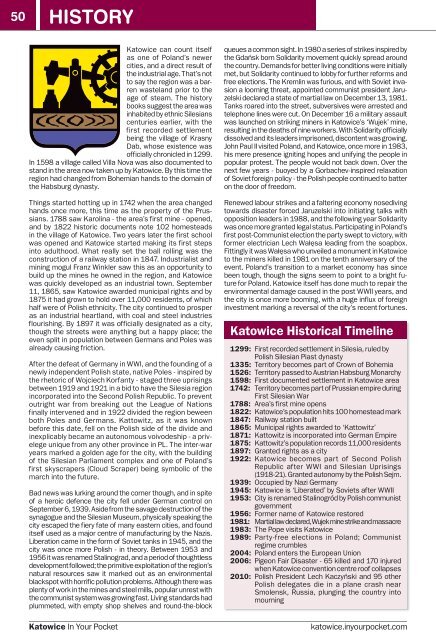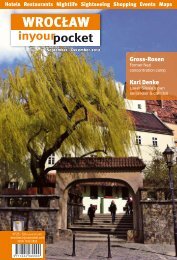Create successful ePaper yourself
Turn your PDF publications into a flip-book with our unique Google optimized e-Paper software.
50<br />
HISTORY<br />
Katowice can count itself<br />
as one of Poland’s newer<br />
cities, and a direct result of<br />
the industrial age. That’s not<br />
to say the region was a barren<br />
wasteland prior to the<br />
age of steam. The history<br />
books suggest the area was<br />
inhabited by ethnic Silesians<br />
centuries earlier, with the<br />
first recorded settlement<br />
being the village of Krasny<br />
Dab, whose existence was<br />
officially chronicled in 1299.<br />
<strong>In</strong> 1598 a village called Villa Nova was also documented to<br />
stand in the area now taken up by Katowice. By this time the<br />
region had changed from Bohemian hands to the domain of<br />
the Habsburg dynasty.<br />
Things started hotting up in 1742 when the area changed<br />
hands once more, this time as the property of the Prussians.<br />
1788 saw Karolina - the area’s first mine - opened,<br />
and by 1822 historic documents note 102 homesteads<br />
in the village of Katowice. Two years later the first school<br />
was opened and Katowice started making its first steps<br />
into adulthood. What really set the ball rolling was the<br />
construction of a railway station in 1847. <strong>In</strong>dustrialist and<br />
mining mogul Franz Winkler saw this as an opportunity to<br />
build up the mines he owned in the region, and Katowice<br />
was quickly developed as an industrial town. September<br />
11, 1865, saw Katowice awarded municipal rights and by<br />
1875 it had grown to hold over 11,000 residents, of which<br />
half were of Polish ethnicity. The city continued to prosper<br />
as an industrial heartland, with coal and steel industries<br />
flourishing. By 1897 it was officially designated as a city,<br />
though the streets were anything but a happy place; the<br />
even split in population between Germans and Poles was<br />
already causing friction.<br />
After the defeat of Germany in WWI, and the founding of a<br />
newly independent Polish state, native Poles - inspired by<br />
the rhetoric of Wojciech Korfanty - staged three uprisings<br />
between 1919 and 1921 in a bid to have the Silesia region<br />
incorporated into the Second Polish Republic. To prevent<br />
outright war from breaking out the League of Nations<br />
finally intervened and in 1922 divided the region beween<br />
both Poles and Germans. Kattowitz, as it was known<br />
before this date, fell on the Polish side of the divide and<br />
inexplicably became an autonomous voivodeship - a privelege<br />
unique from any other province in PL. The inter-war<br />
years marked a golden age for the city, with the building<br />
of the Silesian Parliament complex and one of Poland’s<br />
first skyscrapers (Cloud Scraper) being symbolic of the<br />
march into the future.<br />
Bad news was lurking around the corner though, and in spite<br />
of a heroic defence the city fell under German control on<br />
September 6, 1939. Aside from the savage destruction of the<br />
synagogue and the Silesian Museum, physically speaking the<br />
city escaped the fiery fate of many eastern cities, and found<br />
itself used as a major centre of manufacturing by the Nazis.<br />
Liberation came in the form of Soviet tanks in 1945, and the<br />
city was once more Polish - in theory. Between 1953 and<br />
1956 it was renamed Stalinograd, and a period of thoughtless<br />
development followed; the primitive exploitation of the region’s<br />
natural resources saw it marked out as an environmental<br />
blackspot with horrific pollution problems. Although there was<br />
plenty of work in the mines and steel mills, popular unrest with<br />
the communist system was growing fast. Living standards had<br />
plummeted, with empty shop shelves and round-the-block<br />
queues a common sight. <strong>In</strong> 1980 a series of strikes inspired by<br />
the Gdańsk born Solidarity movement quickly spread around<br />
the country. Demands for better living conditions were initially<br />
met, but Solidarity continued to lobby for further reforms and<br />
free elections. The Kremlin was furious, and with Soviet invasion<br />
a looming threat, appointed communist president Jaruzelski<br />
declared a state of martial law on December 13, 1981.<br />
Tanks roared into the street, subversives were arrested and<br />
telephone lines were cut. On December 16 a military assault<br />
was launched on striking miners in Katowice’s ‘Wujek’ mine,<br />
resulting in the deaths of nine workers. With Solidarity officially<br />
dissolved and its leaders imprisoned, discontent was growing.<br />
John Paul II visited Poland, and Katowice, once more in 1983,<br />
his mere presence igniting hopes and unifying the people in<br />
popular protest. The people would not back down. Over the<br />
next few years - buoyed by a Gorbachev-inspired relaxation<br />
of Soviet foreign policy - the Polish people continued to batter<br />
on the door of freedom.<br />
Renewed labour strikes and a faltering economy nosediving<br />
towards disaster forced Jaruzelski into initiating talks with<br />
opposition leaders in 1988, and the following year Solidarity<br />
was once more granted legal status. Participating in Poland’s<br />
first post-Communist election the party swept to victory, with<br />
former electrician Lech Wałęsa leading from the soapbox.<br />
Fittingly it was Wałęsa who unveiled a monument in Katowice<br />
to the miners killed in 1981 on the tenth anniversary of the<br />
event. Poland’s transition to a market economy has since<br />
been tough, though the signs seem to point to a bright future<br />
for Poland. Katowice itself has done much to repair the<br />
environmental damage caused in the post WWII years, and<br />
the city is once more booming, with a huge influx of foreign<br />
investment marking a reversal of the city’s recent fortunes.<br />
Katowice Historical Timeline<br />
1299: First recorded settlement in Silesia, ruled by<br />
Polish Silesian Piast dynasty<br />
1335: Territory becomes part of Crown of Bohemia<br />
1526: Territory passed to Austrian Habsburg Monarchy<br />
1598: First documented settlement in Katowice area<br />
1742: Territory becomes part of Prussian empire during<br />
First Silesian War<br />
1788: Area’s first mine opens<br />
1822: Katowice’s population hits 100 homestead mark<br />
1847: Railway station built<br />
1865: Municipal rights awarded to ‘Kattowitz’<br />
1871: Kattowitz is incorporated into German Empire<br />
1875: Kattowitz’s population records 11,000 residents<br />
1897: Granted rights as a city<br />
1922: Katowice becomes part of Second Polish<br />
Republic after WWI and Silesian Uprisings<br />
(1918-21). Granted autonomy by the Polish Sejm.<br />
1939: Occupied by Nazi Germany<br />
1945: Katowice is ‘Liberated’ by Soviets after WWII<br />
1953: City is renamed Stalinogród by Polish communist<br />
government<br />
1956: Former name of Katowice restored<br />
1981: Martial law declared, Wujek mine strike and massacre<br />
1983: The Pope visits Katowice<br />
1989: Party-free elections in Poland; Communist<br />
regime crumbles<br />
2004: Poland enters the European Union<br />
2006: Pigeon Fair Disaster - 65 killed and 170 injured<br />
when Katowice convention centre roof collapses<br />
2010: Polish President Lech Kaczyński and 95 other<br />
Polish delegates die in a plane crash near<br />
Smolensk, Russia, plunging the country into<br />
mourning<br />
Katowice <strong>In</strong> <strong>Your</strong> <strong>Pocket</strong> katowice.inyourpocket.com<br />
Katowice Historical Museum © Jan Mehlich<br />
The fact that Katowice hasn’t grown into a popular tourist<br />
destination can probably be explained by the brevity and<br />
slightly dubious nature of our Katowice sightseeing section<br />
- an earnest attempt to cover Katowice’s main (ahem)<br />
attractions. Nope, no castle, no palace, no hip bohemian<br />
district. No pedestrian shopping avenues, bridges or scenic<br />
riverside. Uh, no, no ancient ruins. No Old Town per say.<br />
Alas, a trip around Katowice may call to mind the old adage<br />
‘Beauty is in the eye of the beholder’ (with the coal dirt and<br />
other particulates, in this case).<br />
Spodek and downtown Katowice UM Katowice<br />
No, Katowice won’t be winning any European beauty pageants,<br />
and unlike other urban casualties (hello to our friends<br />
in Warsaw), the city can’t claim to have been beaten by the<br />
Ugly Stick during World War II. No, Katowice was born with<br />
that heirloom in its hand and the Nazis probably snatched<br />
it from here as they rumbled east to the capital. And while<br />
the Soviets returned with it after the war, destroying many<br />
of the buildings on the Rynek in the 1950s to make room for<br />
their modern monuments to concrete, for example, it was<br />
predestiny that Katowice would never be belle of the ball.<br />
A blue collar city to this day, Katowice and its neighbours<br />
in Upper Silesia were born into the working class, growing<br />
up during the industrial revolution and put to work in sooty<br />
katowice.inyourpocket.com<br />
ESSENTIAL <strong>KATOWICE</strong><br />
mineshafts, factories and railway yards. The area’s history is<br />
inextricably entwined with the manufacture of coal and steel<br />
and the stacks, shafts, slagheaps and massive waves of<br />
migrants that followed the discovery of the region’s mineral<br />
resources. As such, any mention of tourism in the district is<br />
usually preceded by the word, ‘industrial.’ <strong>In</strong>deed the derelict<br />
factories and foundries, blackened chimneys and abandoned<br />
maintenance yards of Silesia’s industrial boom represent the<br />
hulking bulk of Silesia’s tourist offerings, and the region is ripe<br />
for renegade tourists eager to explore evidence of a bygone<br />
era. Those interested in industrial tourism are advised to get<br />
their creased hands on a copy of Silesia’s <strong>In</strong>dustrial Monuments<br />
Route - which can be picked up free of charge in any<br />
Silesian tourist information office - and while we’ve covered<br />
many of the entailed sites in this very guide, the region has<br />
plenty more to offer than we have space to include here.<br />
Nikiszowiec<br />
Katowice, for its part, has become a growing business centre<br />
as you’ll glean from the glittering capitalist monoliths built<br />
in recent decades. Those seeking more conventional interpretations<br />
of the word attraction will find plenty of churches<br />
including Christ the King Cathedral - the country’s largest,<br />
one of the best museums in southern Poland in the Katowice<br />
Historical Museum, and anyone paying attention will notice<br />
a number of discreetly handsome townhouses, particularly<br />
along ulica 3-go Maja between the Rynek (C-3) and Plac<br />
Wolności (C-1). Conventional charm has obviously never<br />
been a strength of Katowice, however, as best evidenced by<br />
the bonkers Spodek building (B-3) and the offbeat outland<br />
districts of Nikiszowiec and Giszowiec. The city’s most<br />
bonafide attraction is the immense Park of Culture and<br />
Recreation, which is techincally located in Chorzów. Yes, it’s<br />
always been the shaft (literally) for Katowice, and while being<br />
a tourist in this city may feel a bit like getting dressed for the<br />
theatre and ending up at a Board of Education meeting, we<br />
hope you enjoy it for its oddities, and remember that some<br />
things look most beautiful through beer goggles.<br />
Christ the King Cathedral © PetrusSilesius<br />
July - October 2012<br />
51

















